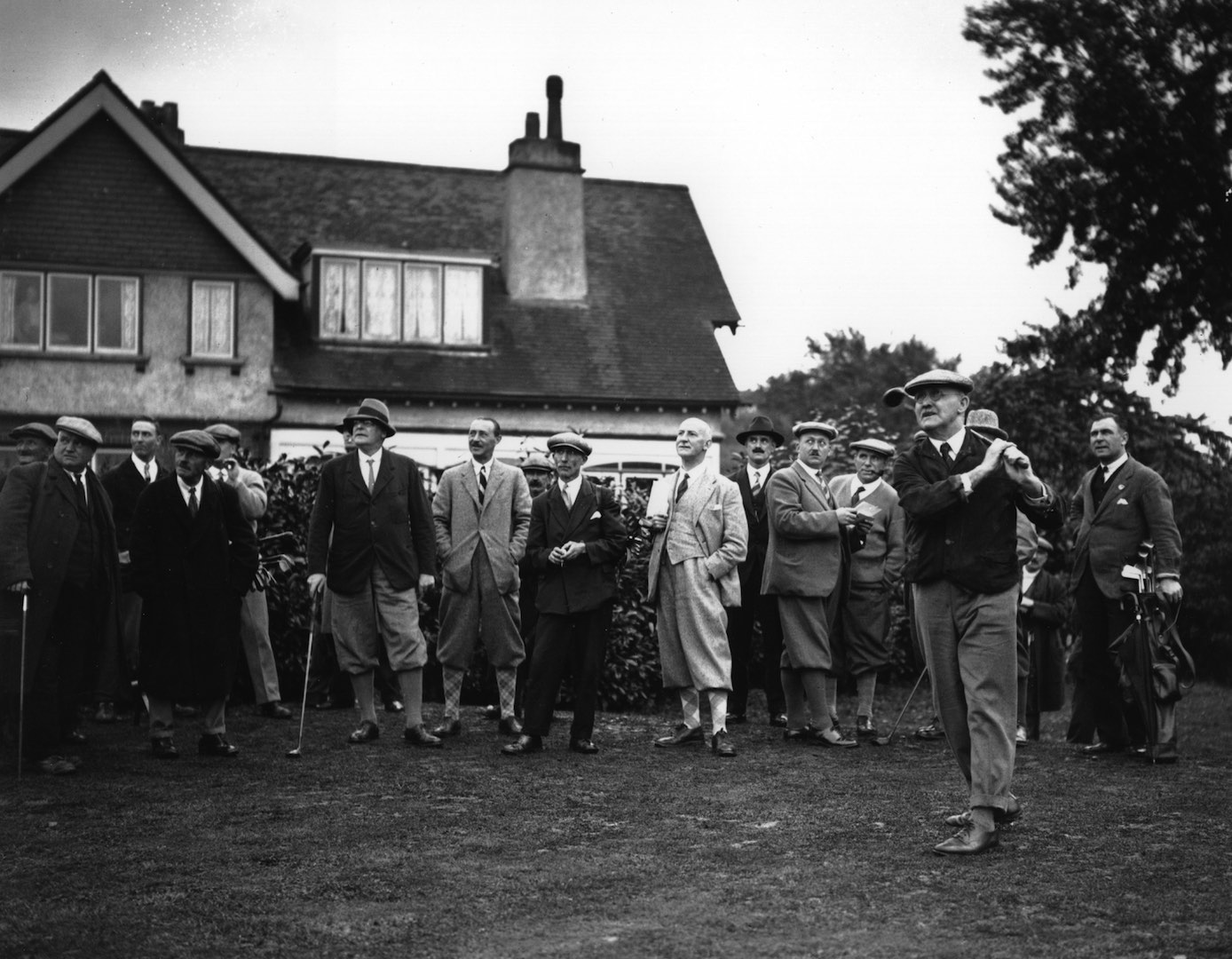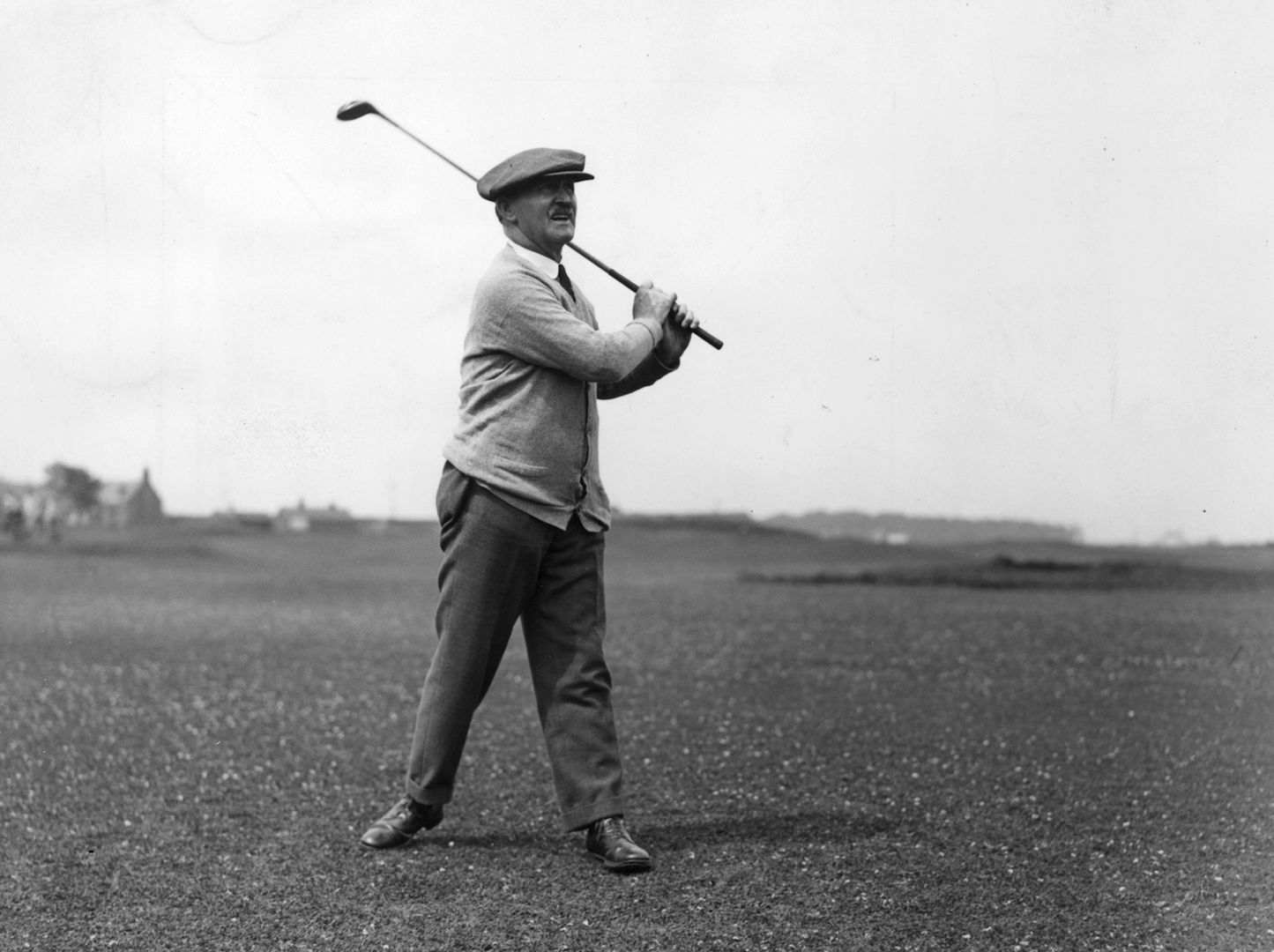Players
Latest > Representing for all the GolfPunks: J H Taylor
Oct 18th, 2017
Representing for all the GolfPunks: J H Taylor
Legendary member of the original 'Big Three'
Words: Christopher Cairns Photography: Getty Images

"Day, Spieth & McIlroy? Pah! We'd 'ave the whippersnappers"
At the end of 2016, the golfing world was getting itself all worked up about the Day/Mcilroy/Spieth Dynasty – ‘The Big Three’ (or maybe four if you include Rickie Fowler).
Back in 2005 the golfing world did exactly the same thing, predicting the dawn of a new era of greats who would dominate golf for the next few years.
Unfortunately, those ‘greats’ included Vijay Singh, who promptly lost the ability to putt from anywhere beyond two feet, Ernie Els, who neededd a small Belgian to tell him he’s 'da man' and buggered up his knee going for a beer on his yacht anyway, and Phil Mickelson who, to be fair, did stop grinning manically long enough to just avoid chucking away that year's USPGA. Even Retief Goosen (supposedly the fifth big one) spent most of that year in what looked like a huff – although it’s hard to tell with him.
But such epoch-defining nonsense has always plagued golf. The sport’s chroniclers seem determined to mark the passage of time by describing golden eras, big fours, big threes and so on.
The earliest collective superlative in golf is that of ‘The Great Triumvirate’. Made up of Harry Vardon, James Braid and JH Taylor, this trio of truly magnificent golfers dominated the sport at the dawn of the 20th century. Between them they won 16 Opens – the only Major in town in those days. The National Matchplay Championship was also won on a regular basis by one of them, as was the French and German opens, while Vardon won the 1900 US Open.
A quick tally of trophies won seems to indicate that Vardon was the Tiger of his day (or should that be the other way round?), Braid next and Taylor bringing up the rear. But it is Taylor, more than his peers, who really deserves our lasting thanks and respect.
It is still true that most professional golfers – most professional sportsmen and women for that matter – come from humble stock. It makes sense. Sport, like rock‘n’roll, remains a well-trodden path out of poverty or lower middle-class tedium. But even in an era when just about every professional golfer was a former club maker or caddy who had decided to take the plunge and bet his livelihood against his ability to play the game, Taylor’s tale of rags to, well, reasonable comfort stands out.
 "Someone call the police, ma. There's a mad bloke in glasses with a golf stick in the garden"
"Someone call the police, ma. There's a mad bloke in glasses with a golf stick in the garden"
John Henry Taylor was born into extreme poverty in rural north Devon in 1871. A perilous hand-to-mouth existence for the family was made worse by the death of his father when Taylor was 11. His mother immediately hoiked the young man out of school and sent him to work in a desperate attempt to keep the family fed and housed.
A stocky, muscular build helped the boy survive jobs such as a mason’s labourer and gardener’s assistant before he stumbled upon employment at the Royal North Devon Golf Club at Westward Ho! Here he became a caddy and then a greenkeeper, all the while using every spare minute he had to learn the game. And before too long he was playing it better than anyone else in the county.
As his pro career began, Taylor decided to make up for his lost schooling by reading the classics. Years of ploughing through the likes of Dickens and Boswell paid such dividends that he was able to write his own, excellent, autobiography without the need of a ghost writer.
 JH demonstrates his new fangled golf matt invention
JH demonstrates his new fangled golf matt invention

1921: From the right: John H Taylor (1871 - 1963) the first English professional to win the Open, James Braid (1870 - 1950), best remembered for outstanding play in the Open. Harry Vardon (1870 - 1937) who won the British and American Open and Fred Herd, winner of the US Open in 1898.
Taylor became so skilled at what was to become the modern golf swing that essential elements of what he and Vardon developed and taught back then – like the flexing of the knees and the stillness of the head throughout the stroke – remain fundamentals of a good swing to this day. Taylor, in fact, was so accurate off the tee that he repeatedly asked for marker posts in the middle of fairways to be removed because he kept hitting the bloody things.
But Taylor was more than just a poor boy made good, more than just an excellent, seminal modern golfer. In class-ridden Edwardian Britain, pro golfers could count on about as much respect as a gay, black, female chimney sweep with a personal hygiene problem. Golfers were gypsies who spent their entire existence on trains and horse-drawn carts in pursuit of the buttons that were on offer to play open competitions and exhibition matches from the highlands to the home counties.
Taylor thought this should be otherwise, and became the driving force behind the founding of the Professional Golfers’ Association (PGA). The PGA remorselessly chipped away at the fossilised snobberies of golf and began eventually to win better working conditions and remuneration for the pros. An indication of how long and hard a battle it was can be deducted from the fact that the PGA was formed in 1901, yet it was not until 1925 that professionals playing in the Open (at Prestwick) were even allowed access to a locker room!
As a golfer only mildly interested in the game’s history, I had vaguely heard of Taylor, though usually in the context of The Great Triumvirate. But when I set out to write a book on the game’s social history and, in particular, the story of how golf came to be a game of haves and have nots, it slowly dawned on me that Taylor’s name was cropping up more and more. Not only was he a pioneer of equal rights for his fellow professionals, he was also a standard bearer for artisan clubs – those early attempts to provide access to private courses for the lower orders. In fact, Taylor himself was a member of the first ever artisan club in England, the Northam club attached to the Royal North Devon, and he co-founded the Artisan Golfers’ Association.
And yet it is not even for this reason that Taylor stands head and shoulders above the professional masses. No, his place in history is guaranteed, in my opinion, because he is the godfather of English public golf.
 "Tilt & stack, my arse!"
"Tilt & stack, my arse!"
Golf’s proletarian origins in Scotland ensured a lasting tradition of public golf north of the border. But the game’s first real incursion into England in the late 19th century was very much a middle and upper- class affair consisting of private clubs with high fees and often higher social pretensions. The first purpose-built municipal course in England aimed at the low paid was Hainault Forest, north east of London, and wasn’t opened until 1909.
Taylor, along with the man who was to become his friend and business partner, Fred Hawtree, designed and built that course and the concept struck a chord with the poor boy from North Devon. Once the First World War was over he began pushing for more public courses to be built across the country. What the ‘cause’, as he called it, needed was a landmark development and he found it at Richmond Park.
Playing the course now, it is hard to appreciate the controversy stirred up by Taylor’s plans. Today there are two mature woodland 18-hole tracks that have become integral parts of the park as a whole. As I discovered in the course of my travels for No Tie Required, the average golfer is no longer the low-paid employee who’s bussed and trammed it across London and then queued for hours just for a few holes of golf. (My playing companions were a partner in an accountancy firm, a marketing consultant and the owner of a pharmaceuticals company.)
But in 1922, when a deputation arrived in Whitehall to propose building a nine-hole course in the park it was all the First Commissioner of Works could do to stop himself having Taylor horse-whipped on the spot. A golf course? In a royal park? For the proles?
Only by agreeing to build on land outside the park proper and with absolutely no financial help from the government did Taylor and his fellow investors win permission to proceed. It wasn’t long, of course, before the small course was a roaring success, additional holes were built and the government saw the light and took over the management – and profits.
Richmond Park blazed a trail for public, municipal golf in England. Its prompted councils from Tyneside to London to follow suit. Scores of courses were built in the next 20 years – many of them by Taylor and Hawtree who established the National Association of
Public Golf Courses in 1927, an organisation that continues the David and Goliath struggle on behalf of the humble ‘muni’. Almost 100 years later, public golf is recognised as the seedbed of the sport in his country – and we have the vision and hard work of JH Taylor to thank for that.
Related to this story:
Representing: The Slammer Sam Snead and his remarkable life
Representing: How Charlie Sifford revoluitonised modern golf
Representing: Max Faulkner - 50 cigarettes a day and little practice = superstar
Representing: Gary Player asks us to punch him in the stomach!
Representing: Dai Rees the legendary Welsh Ryder Cup hero
Representing: How Bernard Gallacher went from Wentworth pro to Ryder Cup legend
Representing: Lee Elder takes up the Charlie Sifford mantle
